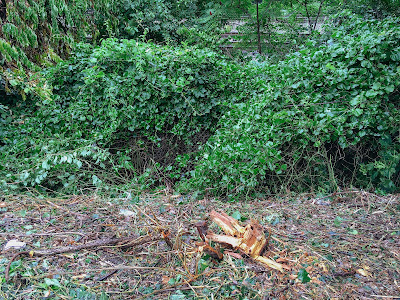Friendly Uproot
Foreword
Throughout the last few years, the thoughts concerning the words: environmental conservation, took on a direct and palpable approach — of recollected experiences, traumas, and stories; inklings of indifference and hopeful optimism, inched towards disconcertment; our fate, our future on this earth, became too apparent to ignore.
Living next to the Truman Parkway, beautiful lichen growth is everywhere near, and it would not be if it weren’t for the trees and vegetation across; the constant emitting-pollutants would’ve had us mort by now. Our tree-canopy, as my friend pointed out, was very apparent upon visiting Hyde Park for the first time, contrasted to the unfortunate lack of tree-canopy in her neighborhood: East Boston. Admittedly, our tree-canopy was a characteristic I took for granted, and often, protested for its lack-of — my perception has changed; I’m appreciative of our existing tree-coverage, but determined for more trees!
Truman Parkway, the suburbanite’s entry path into and from the city — dropping trash and cancer as they go. It is somewhat loathsome and tedious walking along Truman; the sudden (but, expected) inhalation of cancerous emissions; the compulsive need to hold-out on the senses, the constant noise-pollution of engines and tires, and the readily available roadside-trash, are truthfully, aggravating, almost antagonistically so. And it is especially worse during the winter.
Thickly-settled, diverse, and around this time, teeming with conversations — resources are shared; offsprings are favored, it’s a curative environment; holistic and sentient.
We’re taught: no flush cuts, prune precisely, follow the angle, avoid tearing the bark — and perhaps it’s needless to say, but I will anyways: avoid unnecessary cuts and branch removal. Usually, after a site maintenance — it’s beautiful, meant to even excite ideas of a picnic, a jog, walking the dog, but, along Truman, the opposite is true. The appraisal value goes down after maintenance at Truman — ripped and ravaged branches decorate the ground floor; the trees show signs of an un-apparent hurricane; the sidewalks are inlaid by signs of an early fall, a greener fall.
In this eight-months-long series of photographs — nearly an entire four New England seasons — the entire proposal of Friendly Uproot represents the perception of the public, myself included. “Invasive, not-native, a-possible-threat, whatever!” “The vines are choking my front-yard tree? Whatever!” Is what I would say, if the end-result of removal gifted me with a limb-less, still dying tree. Aesthetics should play a big role alongside practically in upkeep; ask most home-owners they'll say they love the clusterful vines on their tree — it looks pretty, even though it may be endangering their tree's health.
What should be done? By spring of next year, the decorative branches which bedazzled the ground floor will begin to rot, provide nutrients and become hidden by new growth. Considering this and despite this, correcting our mistakes should not be left only to Mother Nature; a little clean-up here and there, a little pruning on this and that, is not discouraged.









